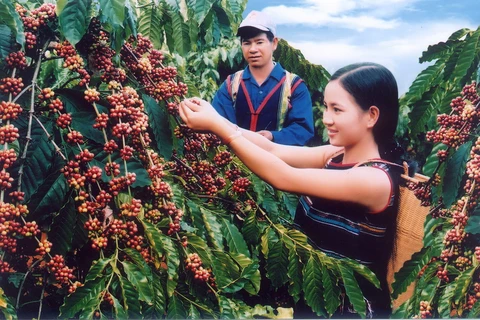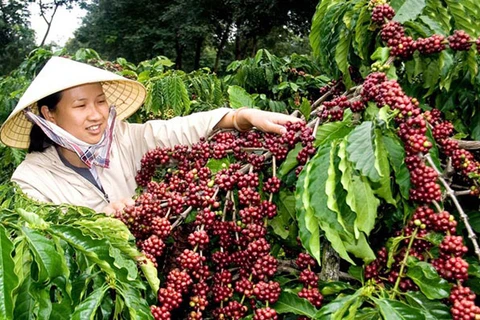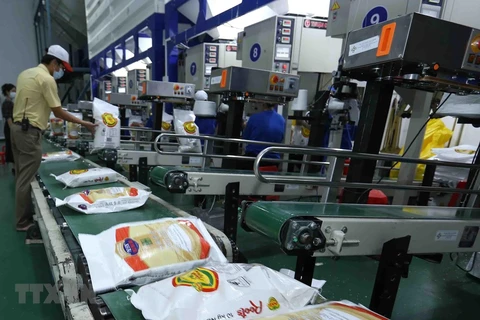Hanoi (VNS/VNA) - Although ranking second in the world, Vietnam's coffee exports are plummeting.
The price of Vietnamese coffee exports is also much lower than the same type of coffee from other countries.
According to a report by the Agro Processing and Market Development Authority under the Ministry of Agriculture and Rural Development, coffee exports in the first eight months of 2019 were estimated at 1.17 million tonnes worth nearly 2 billion USD, down 11.8 percent in volume and 21.4 percent in value over the same period in 2018.
Since the beginning of the year, Germany and the US have continued to be Vietnam's two largest coffee consuming markets, with market shares of 13.7 percent and 9 percent, respectively.
Except for Vietnam’s increase in coffee exports to the Philippines and Malaysia by 22 percent and 3.7 percent, respectively, exports to most of the remaining major markets decreased compared to the same period in 2018.
In addition to falling in export volume, the average export price of coffee in the first seven months of 2019 was only 1,700 USD per tonne, down 11.2 percent year-on-year.
In fact, Vietnam's coffee prices are decreasing in accordance with general global trends. Global coffee prices continued to decline in the first months of 2019 and fell to the lowest level in the past 13 years due to oversupply of the global coffee market.
For example, Vietnam is the largest source of coffee for Spain with two main types – unroasted coffee and decaffeinated coffee, accounting for 42.8 percent and 39.5 percent of the total import value of the world market in the first four months of 2019, respectively.
Spain’s average import coffee price reached 2,710 USD per tonne. Meanwhile, the average import price of coffee from Vietnam is only 1,780 USD per tonne, much lower than the average import price in this market.
Notably, Spain’s average import coffee price from France reached a high of 15,670 USD per tonne, almost nine times as much as the price imported from Vietnam.
The Ministry of Industry and Trade also cited data from the Korean Trade Commission. In the first four months of this year, Vietnam was also the largest coffee exporter in this market with an output of 11,000 tonnes, but the price only reached 1,800 USD per tonne.
Brazil is the second country in terms of output with nearly 10,600 tonnes and its coffee is sold to the Republic of Korea (RoK) at 2,600 USD per tonne. Colombian coffee ranked third in RoK, with over 9,000 tonnes and an average price reaching 3,200 USD per tonne.
An expert in the coffee sector said that Vietnamese coffee is currently exported to over 80 countries and territories around the world with export turnover of over 3 billion USD, accounting for 14 percent of market share and 10.4 percent of value of global coffee exports, ranked second after Brazil.
However, the exported product is mainly coffee beans, accounting for about 90 percent. Therefore, the profit earned is not commensurate with the amount of goods exported.
According to the Agro Processing and Market Development Authority, some Vietnamese coffee products have not met standards required by demanding markets.
This authority predicts that the price of coffee in the short-term will increase due to the supply decrease in major producing countries. In addition, the demand for coffee increasing faster than production will boost the demand for coffee imports in the medium and long term./.
The price of Vietnamese coffee exports is also much lower than the same type of coffee from other countries.
According to a report by the Agro Processing and Market Development Authority under the Ministry of Agriculture and Rural Development, coffee exports in the first eight months of 2019 were estimated at 1.17 million tonnes worth nearly 2 billion USD, down 11.8 percent in volume and 21.4 percent in value over the same period in 2018.
Since the beginning of the year, Germany and the US have continued to be Vietnam's two largest coffee consuming markets, with market shares of 13.7 percent and 9 percent, respectively.
Except for Vietnam’s increase in coffee exports to the Philippines and Malaysia by 22 percent and 3.7 percent, respectively, exports to most of the remaining major markets decreased compared to the same period in 2018.
In addition to falling in export volume, the average export price of coffee in the first seven months of 2019 was only 1,700 USD per tonne, down 11.2 percent year-on-year.
In fact, Vietnam's coffee prices are decreasing in accordance with general global trends. Global coffee prices continued to decline in the first months of 2019 and fell to the lowest level in the past 13 years due to oversupply of the global coffee market.
For example, Vietnam is the largest source of coffee for Spain with two main types – unroasted coffee and decaffeinated coffee, accounting for 42.8 percent and 39.5 percent of the total import value of the world market in the first four months of 2019, respectively.
Spain’s average import coffee price reached 2,710 USD per tonne. Meanwhile, the average import price of coffee from Vietnam is only 1,780 USD per tonne, much lower than the average import price in this market.
Notably, Spain’s average import coffee price from France reached a high of 15,670 USD per tonne, almost nine times as much as the price imported from Vietnam.
The Ministry of Industry and Trade also cited data from the Korean Trade Commission. In the first four months of this year, Vietnam was also the largest coffee exporter in this market with an output of 11,000 tonnes, but the price only reached 1,800 USD per tonne.
Brazil is the second country in terms of output with nearly 10,600 tonnes and its coffee is sold to the Republic of Korea (RoK) at 2,600 USD per tonne. Colombian coffee ranked third in RoK, with over 9,000 tonnes and an average price reaching 3,200 USD per tonne.
An expert in the coffee sector said that Vietnamese coffee is currently exported to over 80 countries and territories around the world with export turnover of over 3 billion USD, accounting for 14 percent of market share and 10.4 percent of value of global coffee exports, ranked second after Brazil.
However, the exported product is mainly coffee beans, accounting for about 90 percent. Therefore, the profit earned is not commensurate with the amount of goods exported.
According to the Agro Processing and Market Development Authority, some Vietnamese coffee products have not met standards required by demanding markets.
This authority predicts that the price of coffee in the short-term will increase due to the supply decrease in major producing countries. In addition, the demand for coffee increasing faster than production will boost the demand for coffee imports in the medium and long term./.
VNA

























